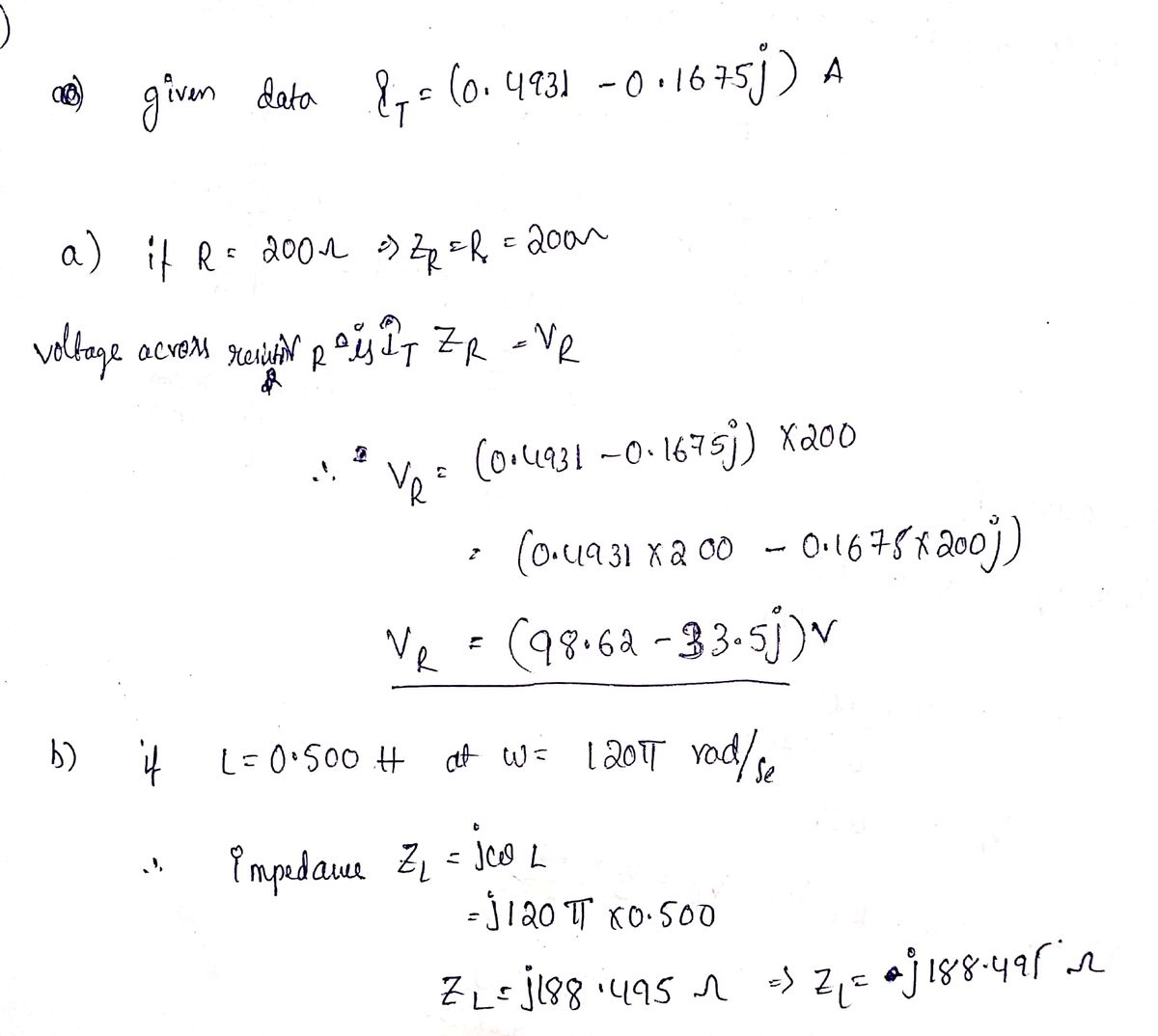а. Still using the circuit above, If it = 0.4931 - 0.1675 j Amperes, running around the loop through each of the components, and R is still 200 Ohms as above, Zr is the impedance of R, what is the voltage VR across the resistor R? Using Ohms Law, VR = iT ZR . b. In a similar way, determine the voltage across the inductor L. Lis still 0.500 Henries, w = 120n radians/s, and ZL is the impedance of L. Using Ohms Law, VL = iT ZL . с. In a similar way, determine the voltage across the capacitor C. C is still 0.22 x 106 Farads, w = 120n radians/s, and Zc is the impedance of C. Using Ohms Law, Vc = iT Zc. d. One of two related laws, attributed to Gustav Kirchhoff, says that if we sum up the voltage changes as we go around a loop in a circuit, we must get a result of zero. You may hear this law called Kirchhoff's Voltage Law, often abbreviated "KVL". In our loop circuit, considering the clockwise direction, the source increases the voltage by Vsrc . It is then decreased by VR, VL, and Vc, arriving where we started. So Vsrc - VR- V L- Vc = 0 . dotermine Vsrc.
а. Still using the circuit above, If it = 0.4931 - 0.1675 j Amperes, running around the loop through each of the components, and R is still 200 Ohms as above, Zr is the impedance of R, what is the voltage VR across the resistor R? Using Ohms Law, VR = iT ZR . b. In a similar way, determine the voltage across the inductor L. Lis still 0.500 Henries, w = 120n radians/s, and ZL is the impedance of L. Using Ohms Law, VL = iT ZL . с. In a similar way, determine the voltage across the capacitor C. C is still 0.22 x 106 Farads, w = 120n radians/s, and Zc is the impedance of C. Using Ohms Law, Vc = iT Zc. d. One of two related laws, attributed to Gustav Kirchhoff, says that if we sum up the voltage changes as we go around a loop in a circuit, we must get a result of zero. You may hear this law called Kirchhoff's Voltage Law, often abbreviated "KVL". In our loop circuit, considering the clockwise direction, the source increases the voltage by Vsrc . It is then decreased by VR, VL, and Vc, arriving where we started. So Vsrc - VR- V L- Vc = 0 . dotermine Vsrc.
Introductory Circuit Analysis (13th Edition)
13th Edition
ISBN:9780133923605
Author:Robert L. Boylestad
Publisher:Robert L. Boylestad
Chapter1: Introduction
Section: Chapter Questions
Problem 1P: Visit your local library (at school or home) and describe the extent to which it provides literature...
Related questions
Question
See attached P2

Transcribed Image Text:а.
Still using the circuit above, If it = 0.4931 - 0.1675 j Amperes, running around the loop
through each of the components, and R is still 200 Ohms as above, Zr is the impedance
of R, what is the voltage VR across the resistor R? Using Ohms Law, VR = iT ZR .
b. In a similar way, determine the voltage across the inductor L. Lis still 0.500 Henries,
w = 120n radians/s, and ZL is the impedance of L. Using Ohms Law, VL = iT ZL .
с.
In a similar way, determine the voltage across the capacitor C. C is still 0.22 x 106
Farads, w =
120n radians/s, and Zc is the impedance of C. Using Ohms Law, Vc = iT Zc.
d. One of two related laws, attributed to Gustav Kirchhoff, says that if we sum up the
voltage changes as we go around a loop in a circuit, we must get a result of zero. You
may hear this law called Kirchhoff's Voltage Law, often abbreviated "KVL". In our loop
circuit, considering the clockwise direction, the source increases the voltage by Vsrc . It is
then decreased by VR, VL, and Vc, arriving where we started. So Vsrc - VR- V L- Vc = 0 .
dotermine Vsrc.
Expert Solution
Step 1

Step by step
Solved in 2 steps with 2 images

Recommended textbooks for you

Introductory Circuit Analysis (13th Edition)
Electrical Engineering
ISBN:
9780133923605
Author:
Robert L. Boylestad
Publisher:
PEARSON

Delmar's Standard Textbook Of Electricity
Electrical Engineering
ISBN:
9781337900348
Author:
Stephen L. Herman
Publisher:
Cengage Learning

Programmable Logic Controllers
Electrical Engineering
ISBN:
9780073373843
Author:
Frank D. Petruzella
Publisher:
McGraw-Hill Education

Introductory Circuit Analysis (13th Edition)
Electrical Engineering
ISBN:
9780133923605
Author:
Robert L. Boylestad
Publisher:
PEARSON

Delmar's Standard Textbook Of Electricity
Electrical Engineering
ISBN:
9781337900348
Author:
Stephen L. Herman
Publisher:
Cengage Learning

Programmable Logic Controllers
Electrical Engineering
ISBN:
9780073373843
Author:
Frank D. Petruzella
Publisher:
McGraw-Hill Education

Fundamentals of Electric Circuits
Electrical Engineering
ISBN:
9780078028229
Author:
Charles K Alexander, Matthew Sadiku
Publisher:
McGraw-Hill Education

Electric Circuits. (11th Edition)
Electrical Engineering
ISBN:
9780134746968
Author:
James W. Nilsson, Susan Riedel
Publisher:
PEARSON

Engineering Electromagnetics
Electrical Engineering
ISBN:
9780078028151
Author:
Hayt, William H. (william Hart), Jr, BUCK, John A.
Publisher:
Mcgraw-hill Education,